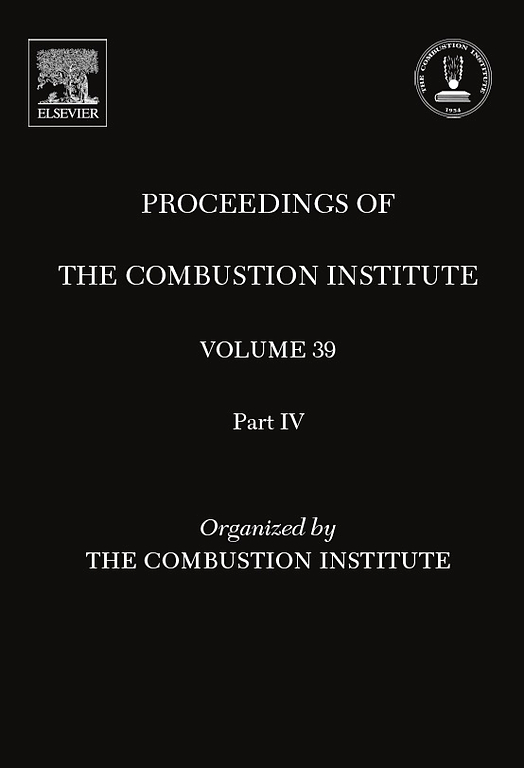液氨漩涡喷射火焰的拓扑特征
IF 5.3
2区 工程技术
Q2 ENERGY & FUELS
引用次数: 0
摘要
在燃气轮机中使用液氨可以减少能量损失和启动时间。然而,液氨的闪沸现象和高潜热使得喷射火焰难以稳定。提高预热空气温度或添加少量氢气作为先导燃料被认为是提高稳定性的有效方法。为了了解火焰的拓扑结构,研究人员同时采用了米氏散射和平面激光诱导 OH 荧光(OH-PLIF)技术来观察液氨喷雾结构和火焰区域信息。结果表明,液氨漩涡喷射火焰呈现出分区特征明显的火焰拓扑结构,包括液滴区、混合区和火焰区。提高预热空气温度会加速液氨的蒸发,从而导致局部等效比和径向火焰分裂的增加。在较低的空气温度条件下,增加氢气混合比对火焰拓扑结构的影响很小。然而,在较高温度条件下,氢气掺混会显著提高上游的反应强度,降低火焰腾空高度,从而使混合区变小。总的来说,要达到较好的火焰稳定效果,需要对这两个因素进行合理匹配,这对液氨燃料燃气轮机燃烧器的发展具有重要的参考价值。本文章由计算机程序翻译,如有差异,请以英文原文为准。
Topology characteristics of liquid ammonia swirl spray flame
The utilization of liquid ammonia in gas turbines can reduce energy loss and start-up time. However, the flash boiling phenomenon and the high latent heat of liquid ammonia make the spray flame difficult to stabilize. Increasing the preheated air temperature or adding a small amount of hydrogen as a piloted fuel are considered as effective methods to enhance the stability. To understand the flame topological structure, simultaneous Mie scattering and planar laser-induced fluorescence of OH (OH-PLIF) techniques were used to visualize the liquid ammonia spray structure and flame region information. Results show that the liquid ammonia swirl spray flame exhibits the flame topological structure of distinct zoning characteristics, including the droplet zone, the mixing zone, and the flame zone. Increasing the preheated air temperature accelerates the evaporation of liquid ammonia, leading to an increase in the local equivalence ratio and radial flame splitting. At lower air temperature conditions, increasing the hydrogen blending ratio has minimal impact on the flame topological structure. However, at higher temperature conditions, hydrogen blending significantly promotes reaction intensity upstream and reduces the flame lift-off height, which makes the mixing zone smaller. In general, to achieve a better flame stability effect, the two factors need to be reasonably matched, which has important reference value for the development of liquid ammonia fueled gas turbine combustors.
求助全文
通过发布文献求助,成功后即可免费获取论文全文。
去求助
来源期刊

Proceedings of the Combustion Institute
工程技术-工程:化工
CiteScore
7.00
自引率
0.00%
发文量
420
审稿时长
3.0 months
期刊介绍:
The Proceedings of the Combustion Institute contains forefront contributions in fundamentals and applications of combustion science. For more than 50 years, the Combustion Institute has served as the peak international society for dissemination of scientific and technical research in the combustion field. In addition to author submissions, the Proceedings of the Combustion Institute includes the Institute''s prestigious invited strategic and topical reviews that represent indispensable resources for emergent research in the field. All papers are subjected to rigorous peer review.
Research papers and invited topical reviews; Reaction Kinetics; Soot, PAH, and other large molecules; Diagnostics; Laminar Flames; Turbulent Flames; Heterogeneous Combustion; Spray and Droplet Combustion; Detonations, Explosions & Supersonic Combustion; Fire Research; Stationary Combustion Systems; IC Engine and Gas Turbine Combustion; New Technology Concepts
The electronic version of Proceedings of the Combustion Institute contains supplemental material such as reaction mechanisms, illustrating movies, and other data.
 求助内容:
求助内容: 应助结果提醒方式:
应助结果提醒方式:


